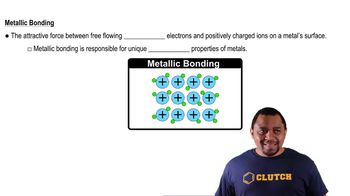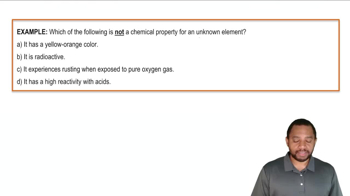The molecular-orbital diagrams for two- and four-atom linear chains of lithium atoms are shown in Figure 12.21. Construct a molecular-orbital diagram for a chain containing six lithium atoms and use it to answer the following questions: c. How many nodes are in the highest-energy molecular orbital?
Which would you expect to be the more ductile element: a. Ag or Mo
 Verified step by step guidance
Verified step by step guidance
Verified video answer for a similar problem:
Key Concepts
Ductility
Metallic Bonding

Comparative Properties of Silver (Ag) and Molybdenum (Mo)

The molecular-orbital diagrams for two- and four-atom linear chains of lithium atoms are shown in Figure 12.21. Construct a molecular-orbital diagram for a chain containing six lithium atoms and use it to answer the following questions: e. How many nodes are in the lowest-energy unoccupied molecular orbital (LUMO)?
Repeat Exercise 12.51 for a linear chain of eight lithium atoms. (f) How does the HOMO–LUMO energy gap for this case compare to that of the four-atom case?
Which of the following statements does not follow from the fact that the alkali metals have relatively weak metal–metal bonding? (a) The alkali metals are less dense than other metals. (b) The alkali metals are soft enough to be cut with a knife. (c) The alkali metals are more reactive than other metals. (d) The alkali metals have higher melting points than other metals. (e) The alkali metals have low ionization energies.
Tausonite, a mineral composed of Sr, O, and Ti, has the cubic unit cell shown in the drawing. (a) What is the empirical formula of this mineral?
The unit cell of a compound containing Co and O has a unit cell shown in the diagram. The Co atoms are on the corners, and the O atoms are completely within the unit cell. a. What is the empirical formula of this compound? b. What is the oxidation state of the metal?
